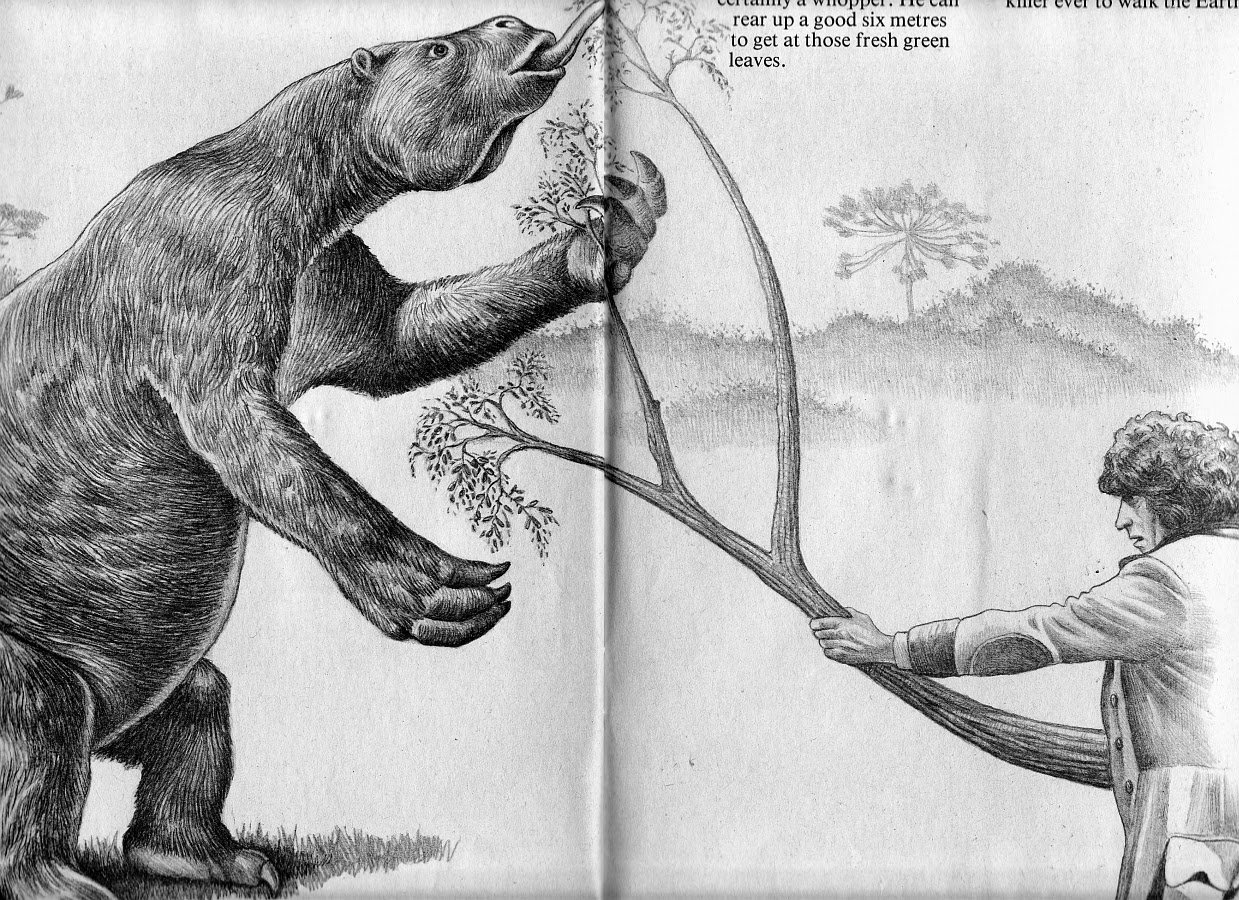So it turns out that
Doctor Who is quite popular - who'da thought? As such, there was much demand for a second instalment of
The Doctor Who Dinosaur Book (1976), featuring everyone's favourite Doctor* - the Fourth Doctor, played by Tom Baker - wandering around and posing like a prat among dinosaur art faithfully traced from the pages of earlier books. I do hope you enjoy.
I didn't mention any thyreophorans last time - but they do feature in the book, so please allow me to rectify the situation forthwith. Spiny-flanked Blackgang Chine
fibreglass dinosaur massacre survivor
Polacanthus puts in an appearance here, in full-on, 1950s-style retro guise. This restoration is nothing at all like the one we'd see today - it resembles an alarmingly armed lizard of some sort, and doesn't have the stocky, flat-topped appearance that ankylosaurs are noted for. No wonder the Doctor looks so unimpressed. If only some properly wide-gauge ankylosaurs could pop along to cheer him up...
...Ah, excellent! As you can see, the Doc is tickled pink at the sight of these stout fellows, who represent the other end of the retro ankylosaur restoration spectrum (yes) - wide, yes, but also short-tailed, no-necked, and with legs shorter than their heads. Vintage restorations tended to conflate true
Ankylosaurus,
Edmontonia, and
Scolosaurus, often under the guise of '
Palaeoscincus'.
TDWDB does refer to this animal as '
Ankylosaurus', but the meld of characteristics is quite obvious here.
Ankylosaurus' contemporary
Triceratops, meanwhile, suffers from a bizarrely huge and fat tail and perspective-related head issues (horns go where?). In fairness, that's only because the original - from
Album of Dinosaurs, illustrated by Rod Ruth - also had these problems, and this is a pretty faithful copy. Mind you, Ruth also managed to insert his creatures into a superbly painted, lush, atmospheric backdrop, whereas these two
Triceratops appear to be fighting in the Late Cretaceous equivalent of the Final Destination stage from
Super Smash Bros. At least we can admire the tartan detailing on the Doctor's waistcoat. Mmm, tartan.
Following my last post, a few people (not least Gary Campbell in the comments) mentioned the 1974
Doctor Who serial
Invasion of the Dinosaurs as something that might be worth a look in the near future. Incidentally (PLUG ALERT), I have already written about it over on
Dave Hone's Guardian blog, so do check that out if you love adorable puppets, Madame Vastra, and an unsubtle disdain for London. For its part,
TDWDB does feature an illustration that looks very much like a puppet, complete with a flexible join where the head's attached - namely, the above ichthyosaur. The source for this one isn't too obvious, although it
is rather generic; any suggestions are welcome.
Before we leave the Mesozoic behind, it's definitely worth mentioning that
TDWDB isn't free from that contemporary dinosaur book staple of allosaurs gnawing on the necks of completely helpless gigantic sauropods, who could quite easily roll over and crush the bastards. Alas, the poor dears suffered a terrible inferiority complex - since they lacked sharp claws and teeth, or spines protruding from their sides, they thought themselves completely hopeless in a fight. Tiny brains, you see. For whatever reason, sauropods are portrayed with oddly pointed teeth in this book...

...Including when they're dead. In spite of being a time traveller with a lifespan extending into millennia, the Doctor has never quite got around to finding out exactly what killed off all the (non-avian) dinosaurs. Therefore this book, alas, offers us only speculation - mentioning insatiable egg-eating mammals (imagine the farts!) and Bakker's Dinoflu Pandemic Hypothesis. Still, the Doctor does manage to rock up a little late and perch on a boulder, looking thoroughly depressed at the sight of giant skeletons and a landscape more featureless than the Lincolnshire district of South Holland.
Having delivered on its title and shown the Doctor and dinosaurs side-by-side,
TDWDB decides to expand its remit and move beyond the K/Pg extinction. A number of important prehistoric representatives of the Age of Hairies show up, including the loveable giant sloth
Megatherium (above). Given the animal's considerable size, it seems that the Doctor can add 'lifting impressively weighty timber' to his list of superhuman attributes. Cute though this is, I'd rather have seen the Doctor giving
Megatherium a hug...or maybe even
riding it. Someone make this happen, please.
And finally...the Doctor documents the evolution of the most terrible killer of them all. That's right...MAN. For, in suitably chauvinistic 1970s style, it is most definitely MAN. With a capital M (and A, and N). On a spread entitled 'AN ANIMAL CALLED MAN', he outlines why MAN is so dangerous:
"He can thinkbetter than any of his rivals. He lives in a group, and co-operates with his fellows. And he's a tooluser...those clever paws of his can hold and shape things. Weapons, in particular. He began with clubs and spears - and in time developed weapons capable of destroying his own planet."
Now, you might scoff at the idea that any modern day weaponry - even every nuclear warhead in the world - could 'destroy the planet'. Irradiate it for millions of years and kill off most lifeforms, sure, but not destroy it completely. Of course, you forget that the Doctor has seen mankind in the future. In the future, blowing up a planet with a bomb the size of a briefcase will be quite trivial - although it'll only be done to
stop marauding armies of Cybermen. Mark my words.
But I digress. Three whole spreads are devoted to stinking MAN, but at least we are treated to the sight of a nude primitive stabbing a
Smilodon straight through the face (above). All that's missing is a dramatic geyser of blood, and we'd be in proper horrorshow territory. Great stuff.
Coming up next time: definitely something different!
*What do you mean, you like David Tennant best? Call yourself a geek? Pish.












